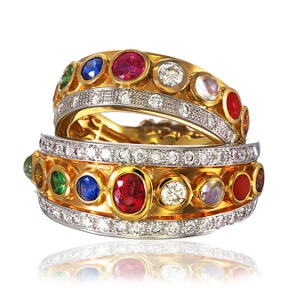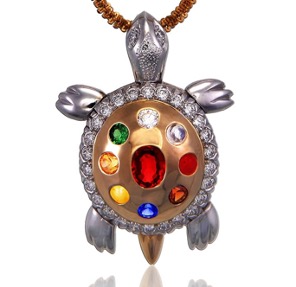Are "Flawless" Gems Only For the Rich?

Are "Flawless" Gems Only For the Rich?
By
Richard S. Brown, Gemologist (GIA)
Often I am asked this question "Are flawless gems only for the rich?" It being explained that according to ancient Vedic (Sanskrit) wisdom, gems are believed to have talismanic powers, with fine flawless gems bringing good fortune, while poor bad quality gems have the opposite effect, i.e., misfortune. The obvious conclusion is that only clean or near-flawless gems are worthy.
One intelligent person may raise the point. "If only flawless gems bring good luck, does that mean that good luck is only for the rich people who can afford the price of a flawless gem?" The question may be expanded, "Flawed, common gems are available to every one, rich and poor alike: but flawless, clean gems are very expensive. Only the wealthy people could afford flawless, top quality gems, and that would leave nothing for the average person. If only clean gems are auspicious, then where does that leave the less affluent? Are flawless gems only for the rich?"
First of all, we must consider what is the source of the information that only clean gems bring good luck. Planetary Gemology (Jyotish-Ratna), is the ancient Asian astrological system of understanding gemstones, taken from Vedic traditions dating long before the birth of Buddha or Christ. It is stated in certain Sanskrit text, such as the Sri Garuda Purana, that gems must be "sujatyam- amalam" to be worthy of use by anyone.
Sujati means good family, denoting the quality of a gem's color. Amala means pure or free of defects, which pertains to a gem's clarity or absence of flaws. It is repeatedly stated in the Sri Garuda-Purana (chapters 68 through 80) that flawed gems are unlucky.
Well, the poor person dislikes 'bad luck' just as much the rich. How could everyone, rich and poor, benefit by using good quality gems?
Let us cite a typical example: Someone desires (or is advised by expert) to use and emerald (a green gemstone for the planet Mercury). After some searching they might conclude either, 1) that flawless emeralds don't exist, or 2) that flawless emeralds are far too expensive. The fact is that there ARE clean, beautiful emeralds on this planet but they are scarce and costly. But if one cannot afford the cost of an auspicious emerald then they can opt for an upa-ratna or "secondary gem." In place of emerald for the planet Mercury (Budha-graha) one could use tsavorite (green grossularite), chrome-green or green tourmaline, chrome- green or green diopside, green peridot or green jade.
If a person were advised to use a Sun jewel because of the Sun being posited in an auspicious position in their horoscope, then they would have a choice of fine gems for the Sun. If their budget (the amount a person can spend) is $100 then they are poor (for totally poverty-stricken persons there is no question of gemstones); if the amount is $1,000 then they are middle class; if the budget is $10,000 or more then they are rich.
But in every case they can have a flawless, natural Sun gem, because Nature has provided a number of natural alternative gems. So, in this case, everyone, the poor, the rich and the middle class could all be happy by purchasing either:
1) Fine red garnet for $100.
2) Fine red spinel for $1,000.
3) Fine red ruby for $10,000.
Along with the Navaratna* or nine planetary gems, there are many other "natural" gemstone choices based on color. These "upa-ratnas" are less expensive than their precious counter parts and yet they conduct the same astral energy of their associated planet. They are also easier to fine without flaws or treatment.
Here is a list of the foremost upa-ratna (semi-precious gems) known to man, along with their ruling planets; RUBY: Red spinel, red garnet and red tourmaline (rubellite) are ruled by the Sun;
PEARL: Moonstone are ruled by the Moon;
RED CORAL: Carnelian and bloodstone are ruled by Mars
EMERALD: Tsavorite, green tourmaline, diopside, peridot and jade are ruled by Mercury;
YELLOW SAPPHIRE: Yellow topaz, yellow beryl (heliodor) and citrine are ruled by Jupiter;
DIAMOND: White (colorless) sapphire, topaz, zircon, beryl and quartz are ruled by Venus;
BLUE SAPPHIRE: Tanzanite (blue zoisite), blue spinel, iolite and amethyst are ruled by Saturn;
HESSONITE: Spessartite, orange Zircon, and other orange garnets are ruled by Rahu (North Node of the Moon);
CAT'S EYE CHRYSOBERYL: Beryl, apatite, fibrolite and tourmaline cat's eye are ruled by Ketu (South Node of the Moon);

Conclusion: If one cannot afford the price of a flawless ruby or diamond, they may opt instead for a flawless but far less expensive red garnet or colorless quartz crystal. All of the Sidereal astrological planets have several varieties of gems the primary, most precious gems and followed by secondary, less expensive types. It's better, for example, to wear a flawless red garnet than a flawed ruby. And better to wear a small but flawless ruby than a larger flawed one.
People interested in enhancing their lives through the auspicious cosmic energies transmitted by planetary gemstones should select only flawless specimens. It is in fact better to wear no gems at all than to wear flawed stones. But since every planet offers a variety of gems from "first-class" to "economy class," one may easily pick a flawless gem, which suits one's individual budget as well as one's horoscope.

Richard S Brown is a Graduate of the Gemological Institute of America (GIA) who has spent most of his life in the East, where he devoted himself to the ancient Oriental science of Graha-anukul-ratna-vishesh-ajna (Planetary Gemology), focusing particularly on the relationship between gemstones, planetary astrology and personal talisman jewelry. His latest book, Ancient Astrological Gemstones & Talismans, was published in 1995 and 2008. In 1999 Richard founded the Planetary Gemologists Association - www.p-g-a.org
